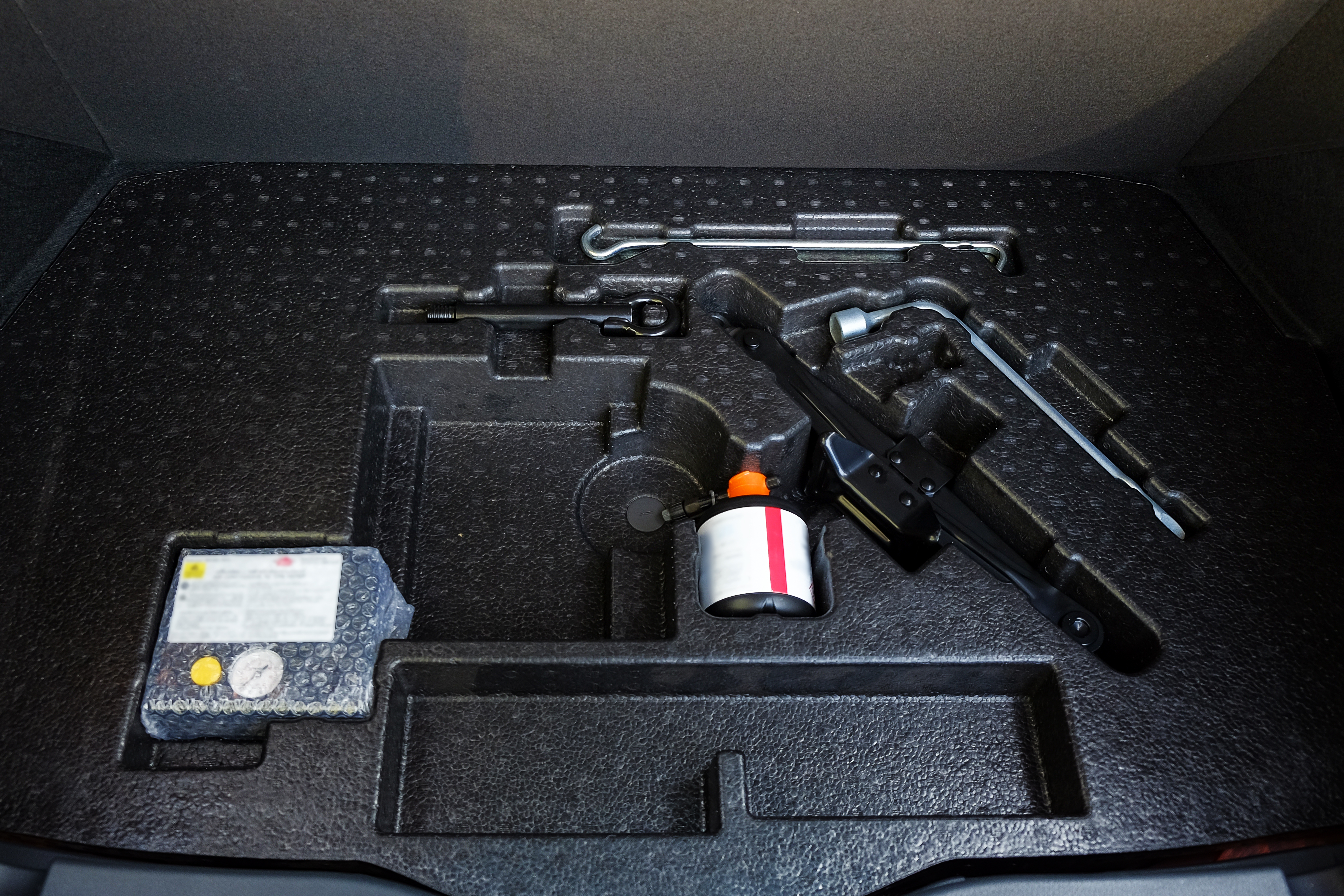
Car manufacturers prefer tyre repair foam over spare tyres. It's part of the equipment that comes with a new car. But how does it work?

When is temporary tyre repair needed?
Despite all caution, it’s not always possible to prevent a puncture in your tyre. While it rarely happens, small, sharp items on the road might not be recognizable while you’re driving. And before you know it, you might need to use tyre puncture foam.
You can fix small punctures up to 4 mm in diameter from nails or screws. This should tide you over until you reach the next garage. Meanwhile, tears, splits or cuts are jobs better left to a professional. But what is tyre foam spray anyway?
What is in a car tyre repair kit?
Car puncture foam is a smaller substitute for a spare tyre. Due to that, it should be where the spare tyre is usually kept within the car. Car manufacturers equip their vehicles ex works with car tyre repair kits. This can be out of practicality and usability, but the kits are also lighter than the spare tyre.
A fully-fledged repair kit consists of two items:
- Sealant: Natural latex (white in colour) provided in a can that can plug a puncture from the inside of the tyre.
- Compressor: Used to transport the sealant to the puncture and to re-inflate the tyre.
Warning stickers: One sticker indicates that your tyre is filled with sealant. The other is a reminder for yourself to maintain the maximum permitted speed for a sealed tyre.
Why are other tools like pliers not included in the car tyre puncture repair kit?
Our Expert's Advice:

Should the reason for the damage still be in the tyre, you shouldn’t remove it. Removing the offending item can cause ruptures.
How do you recognize a punctured tyre?
Most modern cars have a pressure warning system that signifies a too low pressure. So, if the pressure decreases quickly, you’re most likely dealing with a punctured tyre. This is when you need tyre foam spray.
Without a pressure warning system, keep an eye out for unusual driving behaviours in your car. These could be:
- Shuddering steering wheel: The flat tyre is likely in the front, as the car is in imbalance.
- Car pulling to one side: The car is imbalanced in the front.
- Unusual vibrations of the entire car: Several thuds accompany the vibrations.
- Unusual sounds: This can include flapping noises.
When you notice one of these things, please pull over as soon as possible into a traffic safe area. While checking your tyre on public roads, adhere to national driving laws. This can include wearing a safety vest when exiting your vehicle and setting up a hazard triangle. This is for your own safety and that of others.
Quite often, you’ll find the reason for the loss of pressure still embedded in your tyre. If you cannot and you’re unsure which tyre is actually flat, look for the tyre bulging outwards when viewing it from the front.
Our Expert's Advice:

You can tell the difference between a flat and an underinflated tyre by the shape. If the tyre seems like it is collapsing into itself, then it’s just underinflated and needs more pressure. When it bulges outward, you’ll likely need tyre foam to fix a puncture.
How to use the puncture repair kit of your car?
Once you have identified the puncture, make sure that your tyres are still cool. Removing the puncturing item or re-inflating a hot tyre can cause a tyre rupture. Should the tyre be hot, you will need to wait for it to cool down. This can take up to two hours. When it’s cool to the touch, it should be safe to remove the puncturing item. Also park the car so that the puncture is easier to access.
Our Expert's Advice:

Please note that you should only repair punctures up to 4 mm in diameter and when the wheel rims are undamaged. Tyre repair kits are only a temporary solution for you to reach the next garage. Anything larger or even exposed belts, bulging sidewalls, and cracks should be repaired by a professional.
How to use the puncture repair kit of your car?
Once you have identified the puncture, make sure that your tyres are still cool. Removing the puncturing item or re-inflating a hot tyre can cause a tyre rupture. Should the tyre be hot, you will need to wait for it to cool down. This can take up to two hours. When it’s cool to the touch, it should be safe to remove the puncturing item. Also park the car so that the puncture is easier to access.
Using tyre repair foam: A step-by-step guide
1. Unscrew the valve cap.
2. Place the puncture repair foam or gel bottle over the valve and screw it tight.
3. Remove the cap at the other end of the sealant nozzle.
4. Place the compressor nozzle over the new opening of the sealant. You should now have created a chain of valve, sealant and compressor.
5. Inflate the tyre to the required level. You can find this on a sticker on the inside of the driver door or within your owner manual.
6. Switch off the compressor.
7. Remove the sealant from the valve.
8. Place the valve cap back on the tyre.
9. Place the warning sticker on the tyre. This indicates the tyre is filled with sealant.
10. Place the speed reminder sticker in your view within the cockpit.
11. Drive the next 5 kilometres at a maximum speed of 80 kmh with your now foam- or gel-filled tyres to better spread the sealant.
12. Visit a Barum partner as soon as possible.
Keep in mind
- Fixing a puncture with puncture repair spray is not a permanent solution. It is only meant to transport you to the next professional.
- When you’ve foamed a tyre, a professional cannot repair it. You need to buy a new tyre.
A car tyre repair kit comes with a sticker to remind you that you can only drive at speeds up to 80 kmh with a foamed tyre.
What other tyre protectors are there?
Rim protectors
Some drivers swear on additional car wheel protectors for the rims. These are usually self-adhesive protectors placed on the junction between rim and tyre. They protect the rim edge. A much-quoted example is accidentally scraping the rim against a curb. However, the best wheel rim protectors are already manufactured into the actual tyre. Tyres with this additional feature are usually marked with FL, FR, FP, FSL, MFS, ML or RPB.
Using tyre repair foam before a puncture
Our Expert's Advice:

Though it might seem like a good idea, foaming out a tyre before a puncture is not helpful. As soon something punctures your tyre, you most likely won’t notice. The damage can then increase over time and will at worst lead to a tyre blowout.
Tyre repair foam: the advantages
Typically, when you’re buying a new car you will have to decide if you’d prefer a spare tyre or a car tyre repair kit. You can take the following points into consideration:
- Cost per use: Spare wheels cost extra, while tyre foam spray is often included in the price. Once you use the kit, you eventually need to buy a new repair kit. In any case, whether you choose a spare wheel or the repair kit, you will need to buy a new tyre.
- Long term cost: A spare tyre weighs far more than a tyre repair kit. Over the years, you’ll be saving a lot of fuel with the kit.
- Usability: The tyre repair foam is easy to use and quick. Meanwhile, a spare wheel takes time to change to.
- Effectivity: The repair foam isn’t applicable for all damages but covers the smaller ones with less fuss than a spare tyre.
All in all, a car tyre repair kit is easy to use and cheaper to get than a spare tyre.

